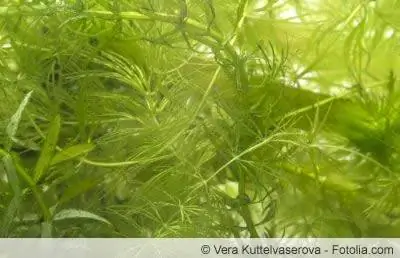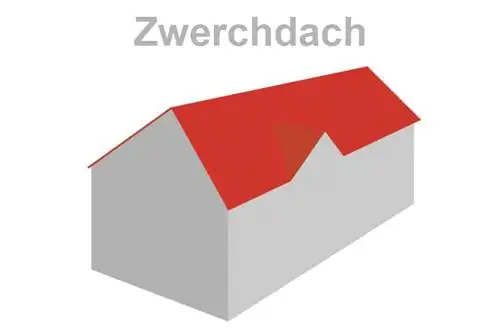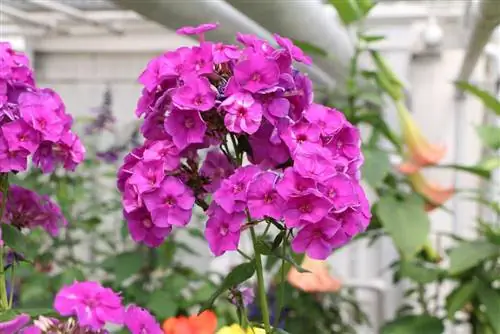- Author admin [email protected].
- Public 2023-12-17 03:39.
- Last modified 2025-06-01 06:48.
The hornleaf, which is also popularly known as hornwort, is one of the plants that can often be found in aquariums or garden ponds. The easy-care aquatic plant with its long, leafy tendrils not only looks beautiful, it also serves as an indicator of the quality of the water.
Hornleaf - popular aquatic plant for ponds and aquariums
Hornleaf is one of the most resilient aquatic plants. They can either be purchased from specialist retailers under the botanical names Ceratophyllum demersum and Ceratophyllum submersum or taken from a local body of water. The evergreen plant has no real roots, only root-like runners. The green tendrils, which can grow to be several meters long in the pond, float freely in the water at or below the surface. Hornleaf is usually inserted into the aquarium or pond as a single shoot. Since the tendrils are very brittle, they must be inserted carefully so as not to damage the plant.
Under no circumstances should the tendrils be planted in the pond or aquarium soil. Then the delicate stems decompose and the plant dies. However, the hornwort can be carefully weighed down with a stick or stone so that the plants stay on the ground and grow upwards from there. It is important to ensure that the stem is not pressed too hard onto the soil. The tufts can be tied together with a plastic wire and anchored in the desired location. If the location is favorable, the plant produces flowers, which, however, remain very inconspicuous.
- evergreen aquatic plant
- free-floating plant without roots
- if possible no contact with pond or aquarium bottom
- hardy
- low maintenance
Hornleaf tends to spread very widely. Especially if the water is very nutrient-rich, the plant quickly overgrows the entire aquarium or pond surface. For aquarium enthusiasts, this is an indication that the water quality is not particularly good for sensitive aquarium inhabitants or pond fish. As soon as the plants become too large, they must be thinned out so that the bottom of the pond and aquarium still receives enough light. Since the stems are very brittle, it is very easy to shorten the horn leaves.
When stocked with fish, several tufts of floating tendrils should remain in the water, as they serve as excellent hiding places for young fish and spawning female fish. But that is almost the only care that the hornleaf or hornwort needs in order to thrive. Most aquarists and pond owners have the problem that the aquatic plants grow too luxuriantly and crowd out other plants.
Growth conditions and reproduction of hornleaf
Horn leaves grow best in nutrient-rich, soft water with a water temperature of more than 16 degrees Celsius. In the aquarium they are green all year round and do not take a break from growth. If the temperature in the garden pond falls below 15 degrees Celsius, the plant is preparing for the winter break. It then forms dense leaf buds, the so-called winter buds, at the tips of the shoots. These then sink to the bottom of the pond and remain there until the water temperature increases again. At more than 16 degrees Celsius, the leaves spread and the horn leaf floats back to the surface of the water.
The hornleaf can be propagated very easily by separating shoots and adding them to the water. They then automatically form the root-like runners that supply the plant with the necessary nutrients. In ponds, reproduction occasionally occurs through flowers. The plant bears both male and female flowers, which release as mature seeds and are pollinated by water.
- nutrient-rich water preferred
- lots of light promotes growth
- Temperatures above 16 degrees Celsius
- Winter break when water temperatures are below 15 degrees Celsius
Problems with keeping the hornleaf
In general, caring for hornleaf or hornwort causes few problems. Pests have little harm to it. Occasionally the plant will take care if the nutrient supply is too low. Hornleaves don't like to change locations. If they are placed in water containing minerals or swimming pool water, they dissolve and leave a somewhat slimy green substance that clouds the water and must be removed. If there are a lot of suspended particles in the pond or aquarium water, the plant quickly becomes unsightly because the particles get caught in the leaves. Cleaning the water can help.
If the plant grows too lush and thus overgrows the water surface, the water quality should be checked and the nutrient supply reduced if necessary. The hornleaf can only tolerate very hard, calcareous water to a limited extent. A white coating then forms on the leaves and makes the plant unsightly. It then only grows very slowly and does not form the characteristic dense green tufts under the water surface.
What you should know about the hornleaf in brief
It is not without reason that the hornleaf is one of the most popular aquatic plants in ponds and aquariums. It provides oxygen, reduces algae growth and offers a beautiful sight thanks to the evergreen tendrils. The attitude requires little care apart from regular thinning and is therefore ideal for beginners. Hornleaves are highly valued by experienced aquarists as an indicator of water quality and as a hiding place for fish.
- The hornleaf is a free-floating native underwater plant that can be found in both aquariums and ponds.
- It prefers a sunny to partially shaded location.
- It is an undemanding plant that grows in both soft and very hard water.
- Horn leaf is a very good source of oxygen and helps against algae through the heavy consumption of nutrients.
- It has no roots to anchor it to the ground and grows best in stagnant or slow-moving water.
- The plant floats through the water and absorbs nutrients through root-like structures that arise from converted sprouts.
- The hornleaf is undemanding and grows very quickly even in low light and low temperatures.
- The propagation of hornleaf and hornwort occurs via side shoots or the buds that overwinter in the pond.
The plant is also very adaptable to temperatures. CO2 supply is not necessary, but supports rapid growth.
In aquariums, the hornleaf / hornwort must be cut back regularly, otherwise it will spread too much. The best way to shorten the plant is to pinch off the upper, fresh green part of the shoot and discard the lower, yellow part of the plant. Buds form in the pond in autumn. The remaining parts of the plants die at temperatures below zero. The buds will sprout again next spring.
Although the horn leaf does not form roots, it can be planted in the substrate. This is often done in aquariums. As a floating plant, the hornleaf floats just below the surface of the water and thus offers good hiding places for fish fry. The plant forms a tubular network inside which the young fish find protection from predators.






